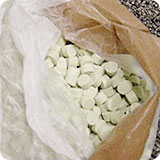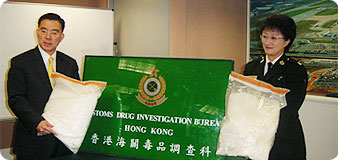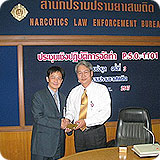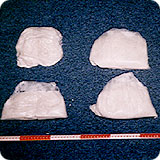 |
|
|
|
 |
|
 |
| |
| Drug Trafficking Trend
5. Drug traffickers took advantage
of the heavy vehicular and passenger flow at the entry/exit
points and the long coastal lines of Hong Kong in smuggling
drugs. Narcotic drugs in bulk were believed to be imported
into Hong Kong through concealment in large shipments
of commercial cargoes. Small-scale trafficking involved
methods like body packing, internal concealment, concealment
inside various items or use of false baggage compartment.
Traffickers also made use of mail and express parcels
adopting diversionary routings to smuggle small quantity
of drugs. |
 |
 |
 |
 |
 Customs
arrested two traffickers at the Hong Kong
International Airport for trafficking in 22
542 tablets of MDMA by body-pack method. Customs
arrested two traffickers at the Hong Kong
International Airport for trafficking in 22
542 tablets of MDMA by body-pack method. |
|
 |
 |
 |
 |
|
 |
 |
|
6. Heroin remained
the most common drug of abuse in Hong Kong. The heroin
seized in Hong Kong mainly originated from the Golden
Triangle and was transported overland to the southern
part of the Mainland such as Guangdong or Yunan Provinces
for stockpiling. Drug syndicates usually employed drug
couriers and use lorries and private cars to smuggle
heroin in small and frequent consignments into Hong
Kong. Some traffickers concealed the drug inside their
body cavities in order to circumvent detection. During
2003, the department arrested a total of 12 drug couriers
(including two with internal concealment) with heroin
seizures ranging from about 100 grams to two kilograms
at the land boundary crossing points. In 2004, 14 drug
couriers were arrested with heroin seizures ranging
from about 0.3 grams to 272 grams at the land boundary
crossing points.
7. Same as in 2002, ketamine was the
second most widely abused drug in Hong Kong. Meanwhile,
ketamine has now become firmly established as the most
prevalent drug of abuse among young persons. In 2003
and 2004 respectively, 47 and 32 cases were detected
with 50 and 34 arrests in connection with ketamine.
Most of the ketamine were sourced from the Mainland,
which were packed in small packets (250 grams) for smuggling
across the boundary by passengers.
8. The sources of herbal cannabis
found in Hong Kong are mainly from Cambodia and Thailand.
Whilst small quantities of herbal cannabis are smuggled
into Hong Kong by means of air parcels, bulk quantities
are usually concealed in sea cargo shipments. Abuse
of cannabis resin is not common in Hong Kong. With diminishing
demand of cannabis resin in Hong Kong, smuggling activities
of this drug have been quiescent for some years. However,
there were three significant cases effected by Customs
in 2003, one of which was the arrest of a Nepalese courier
at the Hong Kong International Airport with seizure
of 6.76 kilograms of cannabis resin. In January 2004,
officers at the airport arrested a Nepalese man arriving
from Kathmandu with the seizure of 6.5 kilograms cannabis
resin. In May of 2004, 9.1 kilograms of cannabis resin
were also detected from a Nepalese woman arriving from
Kathmandu. The drugs were ingeniously pressed into round
strips hidden in dried buffalo meat. |
| |
 |
 |
 |
 |
 Customs
arrested a Nepalese man at the Hong Kong International
Airport for trafficking in 6.76 kilograms
of cannabis resin by internal concealment. Customs
arrested a Nepalese man at the Hong Kong International
Airport for trafficking in 6.76 kilograms
of cannabis resin by internal concealment. |
|
 |
 |
 |
 |
|
 |
 |
9. What worth particular
attention is the first ever detection of cannabis buds
(1.63 kilograms) in Hong Kong by Customs in early February
2004, followed by a significant seizure of 26 kilograms
effected in March, which fetched a total retail price
up as much as $7.8 million. The level of THC (9-tetrahydrocannabinol-the
primary active ingredient in cannabinoids) found in
the seized cannabis buds was in the range of 11 to 16
percent, which showed that their potencies were much
higher than the average one to three percent found in
herbal cannabis. In 2004, cannabis buds were smuggled
into Hong Kong through the mail system and a total seizure
of 40.5 kilograms of cannabis buds were made.
10. The majority of methylamphetamine
(‘ice’) seized in Hong Kong originated from
neighbouring countries including the Mainland, and was
either for local consumption or for small-scale re-export
to other Southeast Asian countries. ‘Ice’
is an important raw material for the manufacture of
"Ya Ba" tablet which is a common drug of abuse
in Malaysia and Indonesia. Due to the keen demand and
high profit margin, ethnic Indonesian, Malaysian and
Taiwan criminal groups have been active in trafficking
‘ice’ from the Mainland to Indonesia, Malaysia
and the Philippines. As a result of vigorous enforcement
actions of the Customs in recent years, "ice"
smuggling activities have been quiescent since the beginning
of 2003. Intelligence indicated that Myanmar has become
a new source of "ice" for its neighbouring
consumption countries including Thailand, Indonesia
and Malaysia.
11. On the other hand, Guam has recently
emerged as a new market for Mainland-produced "ice".
The trend was evidenced by the detection of two "ice"
cases in the first half of 2003. In February 2003, a
joint investigation between Hong Kong Customs and US
DEA led to the seizure of 2.8 kilograms of "ice"
from a parcel that arrived in Guam from Hong Kong. Another
case was effected at the Hong Kong International Airport
in April 2003 with seizure of 3.44 kilograms of "ice"
found on a passenger departing for Guam.
12. The abuse of "ecstasy",
once on a meteoric rise, has rapidly lost its popularity
in the past two years. In 2003, the department cracked
a total of three significant cases, one of which involved
the arrest of two traffickers at the Hong Kong International
Airport with seizure of 22 542 tablets of MDMA. The
seizures, sourced from the Netherlands, were intended
for the market in Japan. Other than the products from
Europe, lower quality "ecstasy-type" tablets
produced on the Mainland are commonly found in night
entertainment venues. These "ecstasy-type"
tablets contain substances such as ketamine, "ice"
and other additives.
13. In 2004, a significant case was
effected with the seizure of 62 700 tablets of high
quality MDMA (concealed inside seven aquarium purifiers
in an express parcel arriving from Belgium) and the
arrest of four persons in the controlled delivery operation.
14. Cocaine, originating in South
America, is only used among a minority of affluent sector
of the community. To circumvent Customs detection, traffickers
have adopted diversionary routes starting from South
American countries to Europe, or the USA or South Africa,
before coming into Hong Kong. Internal concealment method
was popular in cocaine trafficking and it was likely
the result of Customs’ heightened awareness on
passenger luggage and commercial consignments. In 2003,
Customs arrested seven couriers at the Hong Kong International
Airport for trafficking a total of 5.74 kilograms of
cocaine. |
| 15. In a significant
case effected in December 2004, Customs intercepted a
Hong Kong man, arriving from Peru via Amsterdam and found
10.3 kilograms of cocaine in the false compartment of
his suitcases. The total seizure of cocaine in 2004 increased
more than 100 percent to 13.1 kilograms as compared to
5.8 kilograms in 2003, due to the increasing local demand
of cocaine and its growing popularity among the less affluent
sector. |
|
 |
 |
 |
 |
 |
 The
record seizure of cocaine at the passenger
terminal of Hong Kong International Airport
on 4 December 2004. The
record seizure of cocaine at the passenger
terminal of Hong Kong International Airport
on 4 December 2004. |
|
 |
 |
 |
 |
|
 |
 |
 |
 |
 Secret compartments
of the suitcase used to conceal the cocaine.
Secret compartments
of the suitcase used to conceal the cocaine. |
|
 |
 |
 |
 |
|
|
|
 |
|
 |
 |
|
 |
| |
| Drug Enforcement
16. With the enhanced intelligence
support and vigorous enforcement actions, the department
achieved significant results in the suppression of drug
abuse and drug trafficking activities. In 2003, the
department arrested 723 drug offenders, smashed one
drug attenuating centre and eight distribution centres.
Total seizures included 11.95 kilograms of heroin, 11.86
kilograms of ketamine, 51 285 tablets of MDMA (‘ecstasy’),
16.37 kilograms of cannabis, 3.46 kilograms of methylamphetamine
(‘ice’), 5.76 kilograms of cocaine and 28
001 tablets of other psychotropic tablets. In 2004,
the department arrested 700 drug offenders, smashed
one drug attenuating centre and 16 distribution centres.
Total seizures included 11.3 kilograms of heroin, 4.8
kilograms of ketamine, 116 477 tablets of MDMA (‘ecstasy’),
112.2 kilograms of cannabis, 11 kilograms of methylamphetamine
(‘ice’), 13.2 kilograms of cocaine and 26
237 tablets of other psychotropic tablets.
17. On the international co-operation
front, the department continued to take an active role
in the exchange of intelligence and the conduct of joint
operations with other Customs administrations and law
enforcement agencies. In 2003, significant cases included
a seizure of 2.8 kilograms of methylamphetamine and
one arrest in Guam; a seizure of 1.15 million tablets
of MDMA and 13 arrests in Australia and Malaysia; a
seizure of 100 kilograms of heroin and three arrests
in Australia; and a seizure of 20 kilograms of herbal
cannabis and one arrest in Japan. Besides, there were
the smash of a drug factory with a seizure of 1 070
kilograms of methylamphetamine and five arrests in the
Philippines; a seizure of 13.36 million tablets of pseudoephedrine
(precursor for manufacture of methylamphetamine) and
14 arrests in Mexico; and a seizure of 20 000 kilograms
of potassium permanganate (precursor for manufacture
of cocaine) in Turkey.
18. For the year of 2004, significant
cases included a seizure of two kilograms of liquid
methylamphetamine and one arrest in Guam; a total seizure
of 4.91 kilograms of methylamphetamine and two arrests
in Japan in two cases; a total seizure of 1.4 kilograms
of heroin, 2 230 tablets of MDMA and nine arrests on
the Mainland; and the neutralization of a drug attenuating
and storing centre on the Mainland with a seizure of
15 kilograms of heroin and 11 arrests. In addition,
notable cases includes a seizure of 1.2 kilograms of
methylamphetamine and one arrest in New Zealand; a seizure
of 675 kilograms of methylamphetamine and 11 arrests
in the Philippines; a seizure of 15.8 kilograms of liquid
methylamphetamine and one arrest in Australia; and a
total seizure of 53.64 million tablets of pseudoephedrine
(precursor for manufacture of methylamphetamine) and
one arrest in Mexico and the USA in five cases.
 |
 |
 |
 |
 Superintendent
C K Cheung, Daniel paid a liaison visit
to various law enforcement agencies
in Thailand for enhancing mutual cooperation
and intelligence exchange in July 2004.
Superintendent
C K Cheung, Daniel paid a liaison visit
to various law enforcement agencies
in Thailand for enhancing mutual cooperation
and intelligence exchange in July 2004. |
|
 |
 |
 |
 |
|
 |
|
 |
 |
 |
 |
 |
 Customs arrested
two traffickers who were about to depart
for Guam at the Hong Kong International
Airport with seizure of 3.44 kilograms
of methylamphetamine in 2003.
Customs arrested
two traffickers who were about to depart
for Guam at the Hong Kong International
Airport with seizure of 3.44 kilograms
of methylamphetamine in 2003. |
|
 |
 |
 |
 |
|
 |
 |
 |
 |
 |
 Customs record
seizure of 62 700 MDMA tablets on 8
December 2004.
Customs record
seizure of 62 700 MDMA tablets on 8
December 2004. |
|
 |
 |
 |
 |
|
|
| |
 |
|
|
 |
|
 |
 |
|
 |
| |
| Control of Chemicals
20. The department maintains a licensing
system under the Control of Chemicals Ordinance to regulate
the trade of 25 chemicals, which are commonly used for
the illicit manufacture of narcotic drugs and psychotropic
substances.
21. In addition, the department has
been participating in a global co-operation mechanism
to monitor the movements of precursor chemicals in a
bid to prevent illicit diversion. Pre-export Notifications
(PENs) are issued to the importing countries or territories
for verifying the legitimacy of the shipment before
export approval is granted. In 2003 and 2004 respectively,
367 and 463 PENs were issued to 23 and 21 countries.
22. In 2003 and 2004, the department
continued to participate actively in three international
tracking programmes, namely "Operation Purple", "Operation
Topaz" and "Project Prism" for respectively monitoring
the movements of potassium permanganate, acetic anhydride
and chemicals that could be used for illicit manufacture
of amphetamine-type stimulants.
23. Since July 2003, Customs officers
of Customs Drug Investigation Bureau and the Airport
Command have been participating in a prolonged operation
with local and overseas authorities with a view to tracking
shipments of pseudoephedrine tablets exported from Hong
Kong and preventing the same from illicit diversion
for use in the manufacture of drugs. In 2003, the operation
resulted in a total seizure of 13.36 million pseudoephedrine
tablets and the arrest of 14 persons by the Mexican
authority. By the end of 2004, the operation joined
by multi-agencies including the Department of Health
resulted in a total seizure of 66.42 million pseudoephedrine
tablets and the arrest of 15 persons by the US and Mexican
authorities.
24. In April 2003, customs officers
seized at the Hong Kong International Airport 30 kilograms
of potassium permanganate which were found inside an
inbound consignment from Sydney, Australia without a
valid import licence.
|
| |
 |
|
|
 |
|
 |
|
|

